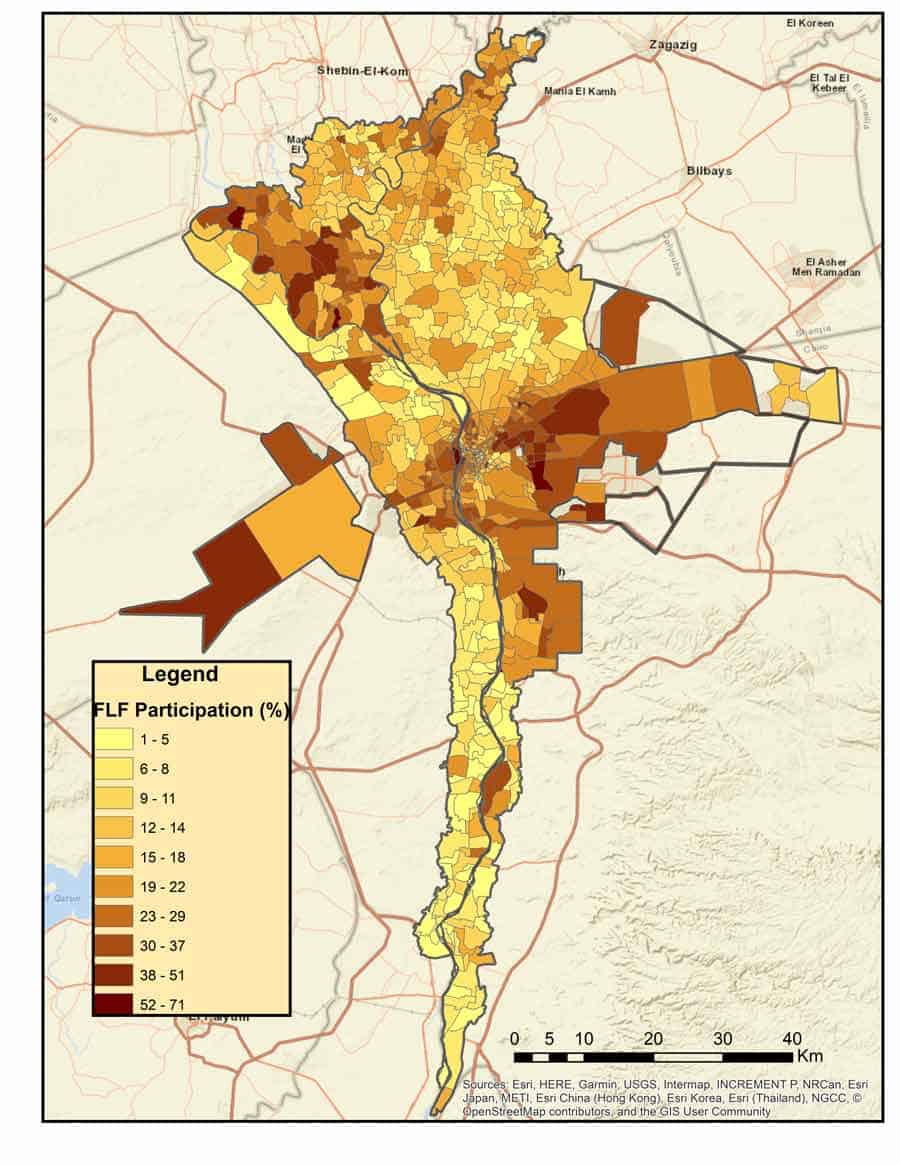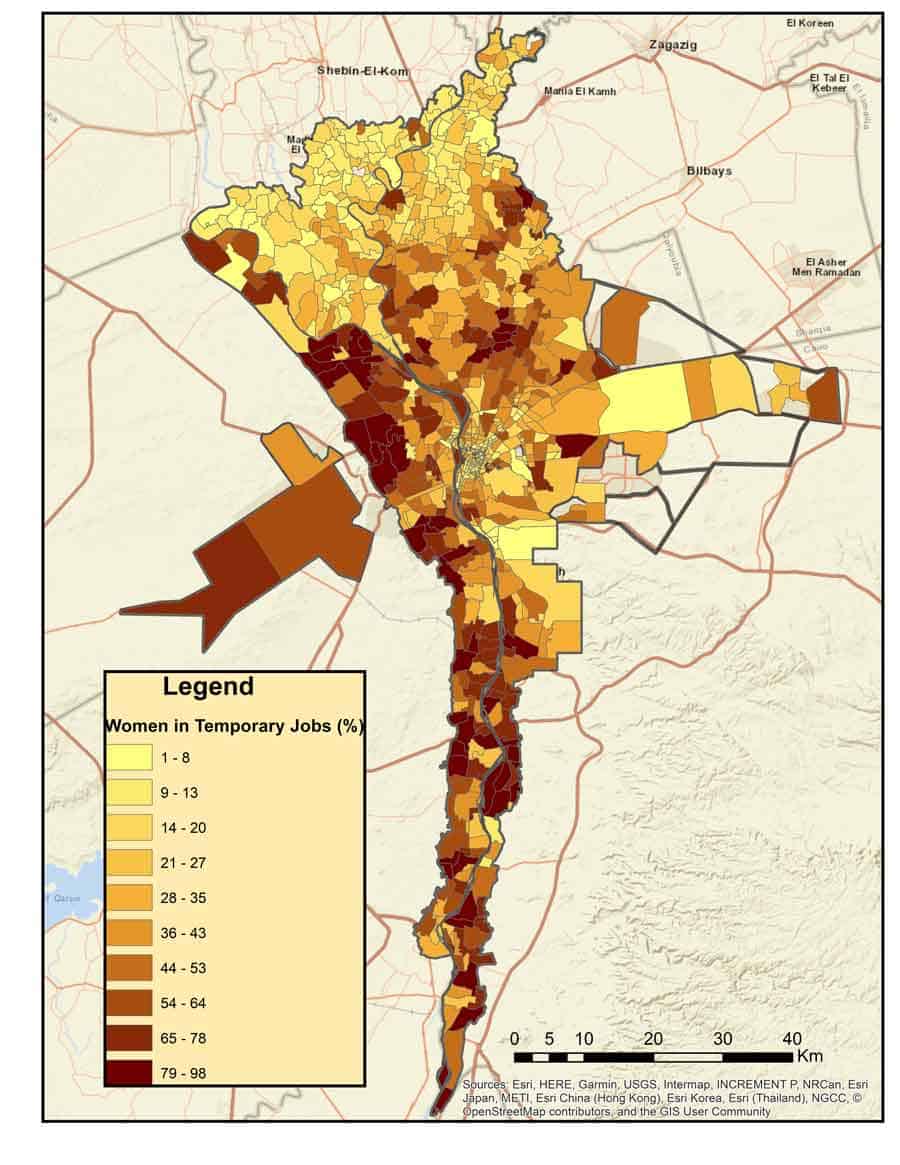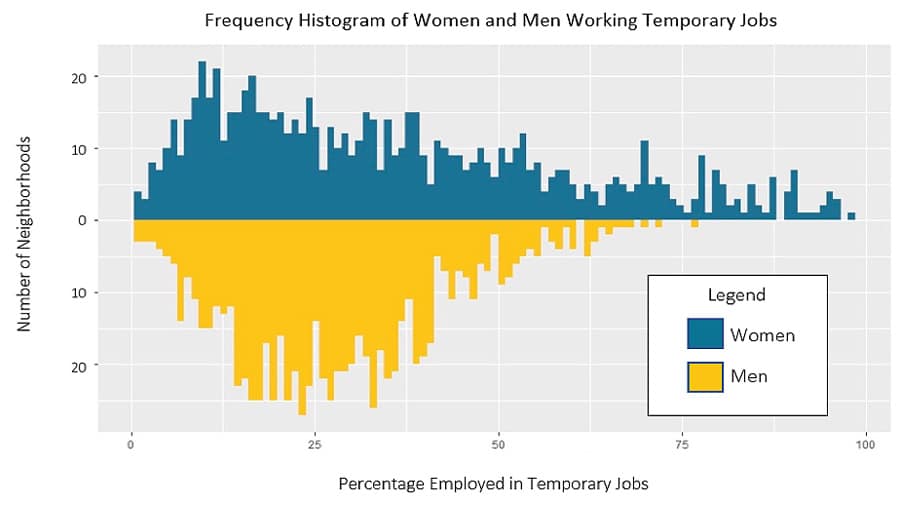Gender, Precarity, and Inequality in Cairo’s Neighbourhoods
Cities are experienced differently by their residents due to a multitude of factors. Analysing several neighbourhoods in Egypt’s Greater Cairo Region, Professors Diane Singerman and Danielle Higgins call for an intersectional approach that considers gender, employment status, and geography when trying to understand causes of urban inequality.
Cities are experienced differently by their residents due to a multitude of factors. Analysing several neighbourhoods in Egypt’s Greater Cairo Region, Professors Diane Singerman and Danielle Higgins call for an intersectional approach that considers gender, employment status, and geography when trying to understand causes of urban inequality.
Understanding Inequality
Tadamun: The Cairo Urban Solidarity Initiative has been investigating spatial inequality within the Greater Cairo Region (GCR), utilising a new, spatially oriented methodology to understand how poverty, density, employment, and education interact with geography, particularly at the shiyakha (neighbourhood) level [1]We gratefully acknowledge Tadamun: The Cairo Urban Solidarity Initiative for use of this dataset which is largely based on the 2006 CAPMAS Egyptian General Census of Population, Housing, and Establishments (2006), the 2011/2012 CAPMAS Household Income, Expenditure, and Consumption Survey, the Egyptian Poverty Map (2013) as well as other sources. For additional details see Planning (in)Justice: Spatial Analysis for Urban Cairo, Tadamun: The Cairo Urban Solidarity Initiative, 2018, pp. 14-23, http://www.tadamun.co/planning-justice-report/?lang=en. Inequality is not just about income, and to understand inequality, we must consider its multifaceted nature and the factors that contribute to it. Unemployment and labour conditions, particularly insecure conditions, are two factors that influence economic inequality. Across the globe, contingent labour, the ‘gig’ economy, labour deregulation, and weak trade unions have restructured labour markets, wages, and conditions of employment, creating precarious jobs that offer workers little security, low wages, and few if any benefits. In Cairo, Tadamun has investigated the interaction of precarious employment with gender and geography, in an economy where female labour participation rates have been very low (23 per cent nationally) and informal economic activities have been quite high.
Labour Force Participation and Employment Modes in the Greater Cairo Region
When we examined women’s labour force participation in the Greater Cairo Region, we found that it varied dramatically from neighbourhood to neighbourhood: from less than 2 per cent to over 70 per cent. Map 1, below, shows this variation. Overall, the mean is 17 per cent and in three quarters of the neighbourhoods in the GCR, female participation in the labour force is below 22 per cent. (It should be noted that these figures are based on the 2006 CAPMAS Egyptian Census.)

Map 1: Female Labour Force Participation Rate, ages 15 and above (percentage), 2006.
However, labour force participation only tells one side of the story. As we can see in Map 2, many women are employed in temporary jobs and the percentage of employed women engaged in temporary work ranges from 1 per cent to 98 per cent between neighbourhoods. What this means is that in many places, temporary jobs may be the only opportunities available. In others, women have greater access to permanent, and perhaps more secure, positions.

Map 2: Percentage of Employed Women in Temporary Jobs, 2006.
Men also work temporary jobs at high rates. In one neighbourhood, as many as 77 per cent of men are employed in temporary work. There are major spatial disparities between neighbourhoods, just as there are for women’s employment, but in three-quarters of the neighbourhoods, the rate of employed men working under temporary contracts is still below 40 per cent. The neighbourhoods with very high percentages of men in temporary contracts are outliers. It is only at the 95th percentile that more than half of men work in temporary contracts. Figure 1 compares the neighbourhood-level percentages of men and women in temporary employment. Most importantly, we see that there are many neighbourhoods where more than half of women work in temporary jobs. Moreover, there are 70 neighbourhoods in the GCR where more than three-quarters of women work in temporary jobs. One of the surprising points from our analysis is that the vast majority of these neighbourhoods are rural. However, because agricultural jobs are a separate category in the census data, we know that we are not simply capturing seasonal, agricultural labour.

Figure 1
Overlapping Inequalities
Temporary work often overlaps with other types of inequalities, contributing to the overall precarity of a neighbourhood. In the 70 neighbourhoods where more than three-quarters of women work temporary jobs, the average female illiteracy rate was 62 per cent. Illiteracy makes workers much more vulnerable when negotiating contracts with employers and finding decent work in the first place. Nearly half of the population in these neighbourhoods lives below the poverty line, compared to about one fifth in the average urban GCR neighbourhood and just under one third in the average rural neighbourhood. Precarious jobs create poverty through low wages, but high poverty rates also create economic necessity such that workers—men and women—may be more willing to take exploitative, low-wage jobs. The cycle of precarious work and poverty presents particular difficulties for women who may have lower mobility and struggle to find work outside of their neighbourhoods. Some women may choose to drop out of the labour force under these conditions if they can afford to do so, explaining the lower rates of temporary work in wealthier neighbourhoods. Others may have no choice but to remain, which is why we see the highest rates of temporary work in the poorest neighbourhoods.
Conclusion
Acknowledging intersectional oppressions – those created by gender, class, and geography – is necessary to fully understand female labour force participation in Egypt, inequality of opportunity, and precarity in the labour market. What the neighbourhood level shows us is that gender and economic inequalities tend to overlap and compound each other in particular places. Policymakers should be targeting specific neighbourhoods to either support women in precarious employment with better services directed at their particular conditions, or encourage investment and secure, decent jobs in those neighbourhoods. Decent work includes benefits, social protections, living wages, and bargaining power – all of which are means to mitigate the uncertainty which is the defining characteristic of precarity. The low overall rates of female labour force participation mask the deeply gendered nature of precarious employment in the GCR. The neighbourhood brings this reality sharply into view.
